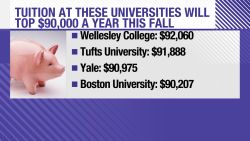The end could be on the horizon for the United Auto Workers union’s four-week long strike against General Motors.
GM CEO Mary Barra met with the UAW negotiators Tuesday morning, according to a union spokesperson. While she had a face-to-face meeting with union president Gary Jones and UAW chief negotiator Terry Dittes last week, this is the first time since the start of the 30-day old strike she sat down with the union’s full negotiating team. A GM spokesman declined to comment on the negotiating session.
The negotiating session comes a day after the UAW called its national council, a group made up of top officials from around the country who represent GM strikers, to a meeting in Detroit on Thursday. That council’s approval is needed before any tentative agreement would go to nearly 50,000 strikers for rank-and-file ratification.
Spokespeople from the union and the company cautioned against assuming the meeting is a sign that a deal has been reached. Both would say only that the talks are continuing. Negotiators are due back at the table Tuesday morning.
But this is the first time since the strike started that the council has been called to a meeting in Detroit. And after 29 days in which the two sides have met every day, and both have been critical of the other’s bargaining positions, the scheduling of the meeting is certainly not a bad sign.
According to a person familiar with the state of negotiations, a lot of progress was made over the weekend. Talks went late into the night Sunday. But the person cautioned some things still need to be buttoned up.
“Clearly, things have progressed to the point that the union felt compelled to call this meeting,” said the person.
The strike has halted work at 31 GM factories and 21 other facilities spread across nine states, mostly in the center of the country. It also caused layoffs at other GM plants in Mexico and Canada that had to shut down because of the disruption in their supply chains, as well as at many of the 10,000 US suppliers who provide auto parts and other goods and services to GM. That may have idled as many as 200,000 additional workers at those companies, according to estimates.
GM has lost more than $1 billion during the strike, according to an estimate from the Anderson Economic Group, which also estimates that strikers have lost about $600 million in wages. The strikers are receiving modest strike benefits that were just raised 10% to $275 a week, rather than pay of more than $30 an hour that veteran workers receive when on the job at GM.
This is not the first sign of progress, but past hopes have been dashed. On Oct. 6 the UAW sent an update to membership saying that negotiations had taken a “turn for the worse.”
Three days after that statement,Barramet face-to-face with union officials for the first time since the start of the strike in an effort to move talks towards an agreement. GM management sent a letter to workers Friday defending the company’s most recent offer and urging an end to the work stoppage — the longest in the auto industry in more than 20 years. The union responded with a statement blaming management for the strike dragging on.
The union has been seeking to have some of the vehicles that GM is now building in Mexico shift back to the US factories. GM announced plans to close four US plants last November. Those plants had about 3,000 UAW members on payroll at the time of the closing announcement. GM said it has found other jobs for about 2,300 of those workers, but many had to relocate to take those other jobs.
According to a person familiar with the talks, the company has offered to to invest $8.3 billion in GM plants, an increase of more than $1 billion from its offer at the start of the strike. It said such investment would create or protect about 5,400 jobs. But the union had continued to push for vehicles to be shifted back from GM plants in Mexico, where it built about 800,000 cars and trucks last year.
The union and management also had been split on GM’s use of temporary workers, who get less wages and benefits than permanent employees. GM said Friday that its offer included a way for those temporary workers to become permanent GM employees. It said it also offered pay raises or lump sum payments for UAW members for each of the four years of the contract, as well as improved profit sharing and a signing bonus.
GM and other automakers are dealing with declining US car sales along with the need to spend billions to develop electric and self-driving vehicles which are seen by many as the future for the industry. GM has said much of the $6 billion a year it hopes to save from plant closings would be invested in those research and development efforts.
But GM has remained very profitable, even in the face of declining sales in both the United States and China, now it’s largest market for car sales. The union has said its members made sacrifices to save the company 10 years ago as it went through bankruptcy and bailout. It argues that given the record profits it has reported since then, the workers deserve to be compensated for those sacrifices.


























